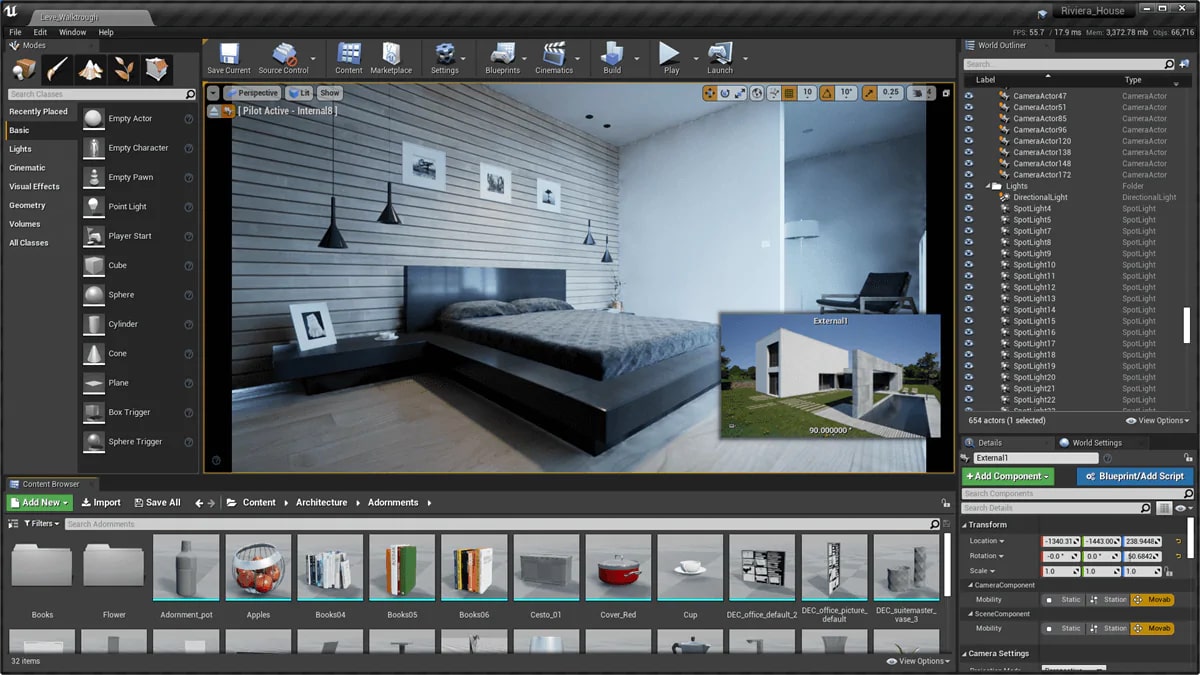Introduction
Unreal Engine 5 has taken the gaming industry by storm with its stunning graphics, enhanced performance, and revolutionary features. With the power to create realistic environments and breathtaking visuals, Unreal Engine 5 has become the go-to choice for many game developers. However, harnessing the full potential of this game development tool requires a powerful graphics card.
A graphics card, also known as a video card or GPU (Graphics Processing Unit), is a crucial component in any gaming setup. It is responsible for rendering images, animations, and visual effects in real-time. When it comes to Unreal Engine 5, the graphics card plays a pivotal role in delivering smooth gameplay, responsive controls, and lifelike graphics.
Choosing the right graphics card can significantly impact the performance and output quality of your Unreal Engine 5 projects. It determines the level of detail, the complexity of scenes, and the overall visual fidelity you can achieve. Therefore, it is essential to understand the minimum system requirements and carefully consider various factors before investing in a graphics card for Unreal Engine 5.
In this article, we will delve into the intricacies of selecting the right graphics card for Unreal Engine 5. We will explore the minimum system requirements, factors to consider, and recommend some of the best graphics cards that offer excellent performance and value for your Unreal Engine 5 projects. Whether you are a professional game developer or an enthusiast, this guide will assist you in making an informed decision to enhance your Unreal Engine 5 experience and bring your virtual worlds to life.
What is Unreal Engine 5?
Unreal Engine 5 is a state-of-the-art game development engine created by Epic Games, renowned for its versatility and cutting-edge features. It offers developers an immersive and powerful platform to create visually stunning and highly interactive games, simulations, and virtual experiences. Unreal Engine 5 pushes the boundaries of graphics capabilities, providing developers with the tools to create breathtaking worlds that are incredibly realistic and detailed.
With Unreal Engine 5, developers benefit from advanced lighting techniques, dynamic global illumination, and enhanced rendering capabilities. These features allow for the creation of lifelike simulations, with realistic shadows, reflections, and textures. The engine also introduces Nanite, a groundbreaking virtualized geometry system that enables the rendering of high-resolution assets in real-time, eliminating the need for time-consuming optimization processes.
Unreal Engine 5’s innovative Lumen technology takes real-time global illumination to the next level. Lumen calculates indirect lighting dynamically, simulating the way light bounces off surfaces, resulting in realistic and dynamic lighting conditions. This technology enhances the visual fidelity of scenes, making them more immersive and captivating for players.
In addition to its powerful graphics capabilities, Unreal Engine 5 offers a comprehensive suite of tools and features. Blueprints, a visual scripting system, allows developers to create gameplay mechanics and interactions without writing code. The engine also facilitates collaborative development through shared project spaces, empowering teams to work together efficiently.
Unreal Engine 5 is designed to be accessible and user-friendly for developers of all skill levels. Its intuitive interface and extensive documentation make it easier for newcomers to get started with creating their own games. Additionally, the engine boasts a vast library of pre-built assets and a supportive community, providing developers with resources and assistance throughout their creative journey.
In summary, Unreal Engine 5 is a game development engine that empowers developers to create visually stunning and highly interactive experiences. With its advanced graphics capabilities, innovative lighting technology, and user-friendly interface, Unreal Engine 5 offers developers the tools they need to bring their creative visions to life.
Importance of Choosing the Right Graphics Card
The graphics card is a crucial component when it comes to running Unreal Engine 5 effectively. It determines the level of visual fidelity, rendering speed, and overall performance of your projects. Choosing the right graphics card for Unreal Engine 5 is of paramount importance for several reasons.
Firstly, a powerful graphics card ensures smooth gameplay and responsiveness. Unreal Engine 5 is known for its stunning graphics and realistic environments. To fully enjoy the immersive experience, you need a graphics card that can handle the demands of the engine without lag or frame rate drops. A capable graphics card will ensure that your games run seamlessly and that you can fully appreciate the intricate details and visual effects.
Secondly, the graphics card directly influences the quality of the visuals in Unreal Engine 5 projects. Whether you’re creating lifelike characters, intricate environments, or mind-blowing visual effects, a high-end graphics card will enable you to achieve impressive levels of realism. It allows for better texture rendering, realistic lighting, and detailed shadows, making your projects visually stunning and engaging for players.
Furthermore, the right graphics card can significantly reduce development time. Unreal Engine 5 relies on real-time rendering, which means that you can make changes to your project and see the results instantly. However, this requires a graphics card that can handle the computational requirements of rendering complex scenes in real-time. With a powerful graphics card, you can iterate and tweak your projects more efficiently, saving you valuable time during the development process.
Additionally, choosing the right graphics card future-proofs your projects. As technology advances and new features are introduced in Unreal Engine 5, a high-end graphics card will ensure that you can take full advantage of these advancements. It will allow you to handle more demanding projects, incorporate complex visual effects, and maintain a competitive edge in the ever-evolving gaming industry.
In summary, selecting the right graphics card for Unreal Engine 5 is essential for delivering smooth gameplay, stunning visuals, and efficient development. It ensures a seamless experience for both developers and players alike, enabling you to unleash the full potential of the engine and bring your creative visions to life with unmatched visual fidelity and performance.
Minimum System Requirements for Unreal Engine 5
To run Unreal Engine 5 effectively and take advantage of its powerful features, you need to ensure that your system meets the minimum system requirements. These requirements serve as a baseline for the hardware components needed to run the engine smoothly and avoid performance issues. While meeting the minimum requirements will allow you to run Unreal Engine 5, it is recommended to exceed these requirements for optimal performance and a better user experience.
The minimum system requirements for Unreal Engine 5 include:
1. CPU: A quad-core Intel processor or equivalent AMD processor is the minimum requirement. However, for optimal performance, it is recommended to have a multi-core processor such as an Intel i5 or AMD Ryzen.
2. RAM: A minimum of 8GB of RAM is required, but having 16GB or more is recommended. Unreal Engine 5 utilizes a significant amount of system memory, and having more RAM will allow for smoother multitasking and better performance.
3. GPU (Graphics Card): The minimum requirement for the graphics card is an NVIDIA GeForce GTX 970 / AMD Radeon R9 290. However, it is highly recommended to have a more powerful GPU to fully take advantage of Unreal Engine 5’s advanced graphics capabilities. A mid to high-end graphics card such as an NVIDIA RTX 3060 or AMD Radeon RX 6700 XT will provide a smoother experience and better visual fidelity.
4. Storage: Unreal Engine 5 requires a minimum of 100GB of free disk space for installation. Additionally, having a fast solid-state drive (SSD) will significantly improve loading times and the overall performance of the engine.
5. Operating System: Unreal Engine 5 is compatible with Windows 10, macOS Catalina (10.15.6) or later, and Linux. It is important to ensure that your operating system is up to date with the latest patches and updates to prevent compatibility issues.
It is worth noting that these are the minimum requirements, and to fully utilize the power of Unreal Engine 5, it is recommended to have a more powerful system. Investing in a high-performance CPU, ample RAM, a robust graphics card, and a fast SSD will result in smoother workflows, faster rendering times, and a better overall user experience.
In summary, meeting the minimum system requirements for Unreal Engine 5 is essential to ensure a smooth and optimal performance. However, exceeding these requirements by investing in more powerful hardware components will enable you to fully unleash the capabilities of the engine and create stunning and immersive experiences.
Factors to Consider when Choosing a Graphics Card
When selecting a graphics card for Unreal Engine 5, it’s important to consider several key factors to ensure you make the right choice for your specific needs. By considering these factors, you can find a graphics card that offers the best balance between performance, budget, and future-proofing.
1. Performance: The performance of a graphics card is crucial for running Unreal Engine 5 smoothly and efficiently. Look for a card with a high CUDA core count (for NVIDIA cards) or stream processors (for AMD cards), as this indicates greater processing power. Pay attention to clock speeds, memory bandwidth, and VRAM capacity, as these contribute to overall performance. Consider benchmarks and reviews to gauge performance in Unreal Engine 5 specifically.
2. Compatibility: Ensure the graphics card you choose is compatible with your system’s hardware and software. Check for compatibility with your CPU, motherboard, and operating system. Be aware of any specific requirements, such as power supply connectors or physical dimensions, to ensure a proper fit.
3. VRAM Capacity: Unreal Engine 5 is highly memory-intensive, so having ample VRAM is crucial. The amount of VRAM will affect your ability to work with high-resolution textures, complex scenes, and multiple assets simultaneously. Aim for a graphics card with at least 8GB of VRAM, though higher capacities will future-proof your system.
4. Cooling Solution: Graphics cards can generate a significant amount of heat, so consider the cooling solution offered by different models. Look for cards with efficient cooling mechanisms, such as multiple fans or liquid cooling, to maintain optimal temperatures and prevent overheating.
5. Power Consumption: Verify that your power supply can handle the power requirements of the graphics card you choose. Higher-end cards typically require more power, so ensure your power supply has the necessary wattage and proper connectors to support the card.
6. Budget: Set a budget for your graphics card and consider different options within that range. Balance performance, features, and cost to find a card that meets your requirements without breaking the bank. Consider factors such as warranty and customer support when evaluating the overall value of a graphics card.
7. Future-Proofing: While focusing on current needs is important, considering future requirements can save you from having to upgrade too soon. Look for graphics cards with up-to-date technologies, such as hardware ray tracing support and DLSS (Deep Learning Super Sampling), which will enhance your ability to create visually impressive projects in Unreal Engine 5.
In summary, consider the performance, compatibility, VRAM capacity, cooling solution, power consumption, budget, and future needs when selecting a graphics card for Unreal Engine 5. By carefully evaluating these factors, you can find a card that maximizes performance, suits your budget, and allows you to create stunning and immersive experiences in Unreal Engine 5.
Best Graphics Cards for Unreal Engine 5
Selecting the best graphics card for Unreal Engine 5 depends on your specific budget, performance requirements, and future-proofing considerations. However, several graphics cards stand out for their exceptional performance and compatibility with Unreal Engine 5. Here are some of the best options to consider:
1. NVIDIA RTX 3090: The NVIDIA RTX 3090 is an absolute powerhouse, offering unrivaled performance and cutting-edge features. With its massive 24GB of VRAM, you can handle the most demanding projects in Unreal Engine 5 with ease. The RTX 3090’s advanced ray tracing and DLSS capabilities provide exceptional realism and performance.
2. NVIDIA RTX 3080: The RTX 3080 is another formidable option, delivering outstanding performance at a more accessible price point. With its 10GB of VRAM and impressive ray tracing capabilities, this card can handle complex scenes and high-resolution textures in Unreal Engine 5 efficiently.
3. Radeon RX 6700 XT: AMD’s Radeon RX 6700 XT offers excellent performance and value for Unreal Engine 5. With 12GB of VRAM, it provides ample memory for demanding projects. The RX 6700 XT’s RDNA 2 architecture and Infinity Cache technology contribute to outstanding performance and power efficiency.
4. GeForce RTX 3060 Ti: The RTX 3060 Ti strikes a great balance between performance and affordability. With 8GB of VRAM and advanced ray tracing capabilities, this card is ideal for creators on a budget who still want to take advantage of Unreal Engine 5’s features.
5. AMD Radeon RX 6800 XT: The RX 6800 XT offers an excellent mix of performance and value. With 16GB of VRAM and top-of-the-line AMD features like Smart Access Memory and Radeon Image Sharpening, this card is well-equipped to handle Unreal Engine 5’s demanding requirements.
Consider your specific needs, budget, and performance expectations when selecting a graphics card for Unreal Engine 5. While these options are among the best, always review benchmarks and user feedback to find the best fit for your particular use case.
Remember, future-proofing is crucial, so consider the longevity of the graphics card’s performance and its compatibility with emerging technologies. By investing in a powerful and future-proof graphics card, you can unleash the full potential of Unreal Engine 5 and create visually stunning and immersive experiences.
NVIDIA RTX 3090
The NVIDIA RTX 3090 is an incredibly powerful graphics card designed for high-performance gaming and content creation, making it an excellent choice for Unreal Engine 5. With its industry-leading specifications, this card offers unmatched performance and cutting-edge features that elevate your Unreal Engine 5 projects to new heights.
One of the standout features of the RTX 3090 is its massive 24GB of GDDR6X VRAM. This abundant VRAM allows you to handle complex scenes, high-resolution textures, and large asset libraries in Unreal Engine 5 without running into memory limitations. It provides a significant advantage when working with detailed environments, realistic lighting, and intricate character models, ensuring smooth performance and reducing the need for compromise.
The RTX 3090 also excels in ray tracing, a technology that enhances the realism of lighting, reflections, and shadows in Unreal Engine 5. With dedicated RT cores, the RTX 3090 delivers real-time ray-traced rendering, allowing for stunning visual effects that enhance immersion in your games and simulations. Realistic reflections and global illumination make virtual worlds appear more lifelike, creating a more immersive and engaging experience for players.
Another notable feature of the RTX 3090 is DLSS (Deep Learning Super Sampling). DLSS leverages AI-powered algorithms to upscale lower-resolution images in real-time, resulting in improved clarity and visual fidelity without compromising performance. With DLSS, you can achieve higher frame rates and maintain smooth gameplay while enjoying crisp and detailed visuals, maximizing both performance and visual quality in Unreal Engine 5.
The RTX 3090’s sheer processing power is also worth mentioning. With 10,496 CUDA cores and a boost clock speed of up to 1.70 GHz, this card can handle the most demanding workflows in Unreal Engine 5 with ease. Whether you’re working on complex scenes, running simulations, or rendering high-quality cinematics, the RTX 3090’s immense horsepower allows for efficient workflows and reduced rendering times.
The cooling solution of the RTX 3090 deserves special mention as well. Designed with a triple-fan setup and advanced cooling technologies, this card maintains optimal temperatures even under heavy loads, ensuring consistent performance and longevity.
However, it’s essential to note that the NVIDIA RTX 3090 comes at a premium price point. While it offers unmatched performance, it may be overkill for some developers, especially those on tighter budgets. Therefore, it’s essential to consider your specific needs, budget, and future requirements when deciding if the RTX 3090 is the right choice for your Unreal Engine 5 projects.
In summary, the NVIDIA RTX 3090 is an exceptional graphics card for Unreal Engine 5, offering unmatched power, abundant VRAM, top-tier ray tracing capabilities, and advanced AI features. If you’re looking to create visually stunning and immersive experiences and have the budget to invest in a high-end card, the RTX 3090 is an excellent choice that will elevate your Unreal Engine 5 projects to new heights.
NVIDIA RTX 3080
The NVIDIA RTX 3080 is a high-performance graphics card that offers an excellent balance between price and performance, making it an ideal choice for Unreal Engine 5 projects. With its powerful specifications and advanced features, the RTX 3080 delivers impressive rendering capabilities and enhances the visual fidelity of your games and simulations.
One of the key features of the RTX 3080 is its 10GB of GDDR6X VRAM. This generous amount of VRAM allows for the smooth handling of complex scenes, high-resolution textures, and advanced visual effects in Unreal Engine 5. It provides ample memory to work with large asset libraries, ensuring optimal performance and reducing the risk of running into memory limitations.
The RTX 3080 also excels in ray tracing, a technology that brings lifelike lighting, reflections, and shadows to your Unreal Engine 5 projects. With dedicated RT cores, the RTX 3080 delivers real-time ray-traced rendering, resulting in stunning visual effects and improved immersion. The realistic reflections and global illumination provided by ray tracing enhance the overall visual quality of your games, making virtual worlds appear more realistic and engaging.
In addition to ray tracing, the RTX 3080 supports DLSS (Deep Learning Super Sampling) technology. DLSS leverages artificial intelligence to upscale lower-resolution images in real-time, delivering improved clarity and visual fidelity without sacrificing performance. With DLSS, you can achieve higher frame rates and maintain smooth gameplay while having highly detailed and crisp visuals.
Performance-wise, the RTX 3080 boasts 8,704 CUDA cores and a boost clock speed of up to 1.71 GHz, providing the horsepower needed for demanding Unreal Engine 5 projects. Whether you’re working on complex scenes, running simulations, or rendering cinematic sequences, the RTX 3080 enables efficient workflows and reduces rendering times, delivering smooth and responsive performance.
The cooling solution of the RTX 3080 is also worth noting. Equipped with a triple-fan design and advanced cooling technologies, the card ensures optimal temperature management even during intense workloads. This results in consistent performance and longevity, allowing you to tackle Unreal Engine 5 projects without worrying about overheating.
While the RTX 3080 offers exceptional performance, it’s important to consider your specific needs and budget when choosing a graphics card. Depending on the complexity of your projects and your budget constraints, the RTX 3080 may be the ideal choice for delivering high-performance graphics and immersive experiences in Unreal Engine 5.
In summary, the NVIDIA RTX 3080 is a top-tier graphics card that strikes a balance between price and performance. With its ample VRAM, impressive ray tracing capabilities, AI-powered DLSS technology, and powerful processing performance, the RTX 3080 is a great choice to elevate your Unreal Engine 5 projects to the next level.
Radeon RX 6700 XT
The Radeon RX 6700 XT, produced by AMD, is a powerful and cost-effective graphics card that delivers excellent performance for Unreal Engine 5 projects. With its advanced features and impressive specifications, the RX 6700 XT offers a compelling option for game developers and content creators looking to maximize their Unreal Engine 5 experience.
One of the standout features of the RX 6700 XT is its 12GB of GDDR6 VRAM. This ample VRAM capacity enables smooth handling of high-resolution textures, complex scenes, and detailed assets in Unreal Engine 5. With a generous amount of memory, developers can create immersive environments and lifelike characters without worrying about performance issues related to running out of VRAM.
The RX 6700 XT leverages AMD’s RDNA 2 architecture, which provides a significant performance boost over previous generations. Combined with Infinity Cache technology, the RX 6700 XT offers enhanced memory efficiency and faster access to frequently used data. This translates to improved performance in Unreal Engine 5, enabling smoother workflows and more responsive real-time rendering.
Ray tracing is another notable feature of the RX 6700 XT. Although not as powerful as the top-of-the-line NVIDIA options, it still delivers impressive results. Ray-traced lighting, reflections, and shadows bring a new level of realism to Unreal Engine 5 projects, enhancing the visual fidelity and immersion of your games and simulations.
When it comes to sheer processing power, the RX 6700 XT boasts 2,560 Stream Processors and a boost clock speed of up to 2.58 GHz. This allows for efficient scene rendering, smoother gameplay, and faster multimedia encoding and rendering. The combination of high core count and clock speed ensures that you can tackle demanding Unreal Engine 5 projects without compromise.
In terms of cooling, the RX 6700 XT utilizes AMD’s robust cooling solution. With a dual- or triple-fan design, the card effectively dissipates heat, ensuring optimal temperatures even during intense workloads. This results in consistent performance and extended card lifespan.
The RX 6700 XT’s affordability compared to some high-end options makes it an attractive choice for developers on a budget. It offers a solid balance between price and performance, making it a worthwhile investment for game developers and content creators looking to take advantage of Unreal Engine 5’s capabilities without breaking the bank.
In summary, the Radeon RX 6700 XT is a powerful graphics card that offers excellent performance, ample VRAM, and advanced features for Unreal Engine 5. With its competitive price and impressive specifications, the RX 6700 XT is a compelling choice for developers who want to create visually stunning and immersive experiences without compromising on performance or budget.
GeForce RTX 3060 Ti
The GeForce RTX 3060 Ti, produced by NVIDIA, is a mid-range graphics card that offers impressive performance and affordability for Unreal Engine 5 projects. With its advanced features and competitive specifications, the RTX 3060 Ti provides an excellent balance between cost and performance for game developers and content creators.
One of the key features of the RTX 3060 Ti is its 8GB of GDDR6 VRAM. This provides sufficient memory for handling complex scenes, high-resolution textures, and detailed assets in Unreal Engine 5. The ample VRAM capacity enables smooth multitasking and efficient rendering, and it allows for the creation of visually stunning environments without running into memory limitations.
The RTX 3060 Ti is equipped with NVIDIA’s renowned ray tracing technology, offering realistic lighting, reflections, and shadows in real-time. While not as powerful as higher-end RTX models, the RTX 3060 Ti still delivers impressive ray tracing performance, enhancing the visual fidelity and immersion of your Unreal Engine 5 projects.
In terms of raw processing power, the RTX 3060 Ti boasts 4,864 CUDA cores and a boost clock speed of up to 1.67 GHz. This ensures smooth real-time rendering, fluid gameplay, and efficient content creation in Unreal Engine 5. The combination of high core count and clock speed enables developers to tackle demanding projects with ease, making the RTX 3060 Ti well-suited for both game development and multimedia tasks.
The RTX 3060 Ti features the DLSS (Deep Learning Super Sampling) technology, which leverages artificial intelligence to upscale lower-resolution images without significant loss in visual quality. This results in improved performance and better frame rates while maintaining crisp and detailed visuals, allowing for a smoother Unreal Engine 5 experience.
In terms of cooling, the RTX 3060 Ti utilizes NVIDIA’s efficient cooling solution, featuring dual or triple fans to dissipate heat effectively. This helps maintain optimal temperatures and ensures consistent performance even during prolonged gaming or rendering sessions.
One of the key advantages of the RTX 3060 Ti is its affordability compared to higher-end graphics cards. It offers exceptional performance for its price, making it an attractive option for budget-conscious developers who still want to take advantage of Unreal Engine 5’s capabilities without compromising on quality.
In summary, the GeForce RTX 3060 Ti is a mid-range graphics card that offers impressive performance, ample VRAM, and advanced features for Unreal Engine 5. With its competitive pricing and solid specifications, the RTX 3060 Ti is a reliable choice for developers who want to create immersive and visually captivating experiences while staying within their budget.
AMD Radeon RX 6800 XT
The AMD Radeon RX 6800 XT is a high-performance graphics card that offers impressive capabilities for Unreal Engine 5 projects. With its advanced features and cutting-edge specifications, the RX 6800 XT provides outstanding performance and visual fidelity, making it an excellent choice for game developers and content creators.
The RX 6800 XT boasts a generous 16GB of GDDR6 VRAM, allowing for smooth handling of high-resolution textures, complex scenes, and detailed assets in Unreal Engine 5. The ample VRAM capacity ensures that developers have sufficient memory to create visually stunning environments and lifelike characters without concerns of running out of memory.
Powered by AMD’s RDNA 2 architecture, the RX 6800 XT delivers exceptional performance and efficiency. The architecture incorporates advanced technologies such as Infinity Cache and Smart Access Memory, which optimize memory utilization, improve data access speeds, and boost overall performance in applications like Unreal Engine 5. These features contribute to faster loading times, improved rendering speeds, and smoother workflows.
The RX 6800 XT also supports ray tracing, offering realistic lighting, reflections, and shadows for enhanced visual fidelity in Unreal Engine 5 projects. Although not as powerful as NVIDIA’s top-tier options, the ray tracing performance of the RX 6800 XT still delivers impressive results. This technology enhances the overall immersion and realism of virtual worlds, making your games and simulations more visually captivating.
In terms of processing power, the RX 6800 XT features 4,608 stream processors and a boost clock speed of up to 2.25 GHz. These specifications enable the efficient rendering of complex scenes, smooth gameplay, and faster multimedia encoding and rendering in Unreal Engine 5. The card’s high core count and clock speed provide the necessary horsepower for demanding tasks, ensuring a seamless development experience.
The cooling solution of the RX 6800 XT is designed to optimize thermal dissipation while maintaining low noise levels. Utilizing a triple-fan design and advanced cooling technologies, the card effectively manages temperatures, allowing for consistent performance and prolonged lifespan.
While the RX 6800 XT offers exceptional performance, it’s essential to consider your budget and specific requirements when choosing a graphics card. The RX 6800 XT falls into the high-end category and may be more suitable for developers and content creators who require top-tier performance and are willing to make a significant investment.
In summary, the AMD Radeon RX 6800 XT is a high-performance graphics card that excels in handling Unreal Engine 5 projects. With its ample VRAM, advanced features, and impressive specifications, the RX 6800 XT offers exceptional performance and visual fidelity, empowering developers and content creators to bring their creative visions to life.
Conclusion
Choosing the right graphics card for Unreal Engine 5 is crucial for optimizing performance, achieving stunning visuals, and enhancing the overall user experience. Throughout this guide, we have explored the factors to consider when selecting a graphics card, highlighted the minimum system requirements for Unreal Engine 5, and recommended some of the best options available.
The graphics card you choose should meet or exceed the minimum system requirements for Unreal Engine 5. Consider factors such as performance, VRAM capacity, compatibility, cooling solutions, power consumption, budget, and future-proofing to make an informed decision.
If budget is not a constraint, high-end options such as the NVIDIA RTX 3090 and AMD Radeon RX 6800 XT offer unparalleled performance and advanced features. These cards are ideal for developers and content creators who require top-tier graphics capabilities and are working on complex projects in Unreal Engine 5.
For those on a more modest budget, the NVIDIA RTX 3080, Radeon RX 6700 XT, and GeForce RTX 3060 Ti provide excellent performance and value. These cards offer a solid balance between price and performance, making them suitable for a wide range of Unreal Engine 5 projects.
Remember to consider both current and future needs when choosing a graphics card. Investing in a graphics card that can handle future advancements in technology will ensure that you can make the most of Unreal Engine 5’s capabilities in the long run.
Ultimately, the choice of graphics card for Unreal Engine 5 depends on your specific requirements, budget, and performance expectations. Whether you opt for a high-end powerhouse or a mid-range option, choosing a graphics card that matches your needs will allow you to leverage Unreal Engine 5’s advanced features and create visually stunning, immersive experiences.
Take the time to research and compare different options, read reviews, and consult with experts to make an informed decision. By selecting the right graphics card, you can unlock the full potential of Unreal Engine 5 and bring your creative visions to life with unparalleled graphics performance and visual fidelity.

























